Introduction
Many religions use figures to represent their faith and convictions, but in Islam, the use of figures is seen as a form of idolatry and worldly thus the discouragement of its use. Calligraphy as a form of writing and art was adopted. It is a significant form of visual art in Islamic architecture.
This is due to its simplicity in conveying messages such as the Quran and Mohammed’s sayings and teachings. It is used to express the Muslims’ faith and identity and brings forth a great type of decorative art. Calligraphy inscriptions are everywhere in the Muslim culture: in the Quran, mosque, madrasa, the libraries and mausoleums, tombs, palaces, and so on. This raises the subject of the use of calligraphy in the Muslim world. How is modern-day technology innovation influencing the use of this form of art? In what ways are the Muslims trying to preserve the art? In this paper, the focus is made on the history and use of calligraphy as a form of Islamic architecture in the Timurid and its contemporary development.
Islamic history
Islam commenced in the Arabian Peninsula. The prophet Muhammad was born in 570 AD in Mecca (“What is Islam?” 1). He was raised by his mother who died when he was 6 years old. His grandfather took over after his mother’s death. Meanwhile, people in Mecca were worshiping gods, goddesses and idols. In 610AD, he experienced his first vision from God and from then onwards, he embraced Islam and proclaimed Allah as the true God. He preached Islam to the people with difficulty due to their heavy opposition. In 621 AD, he went to Medina with some people from the Arab tribe. In Medina, Hejira took place and Muhammad was almost killed. A battle took place between the Jews and those from Medina and Muhammad’s men wore it. His rule was tightened and people acknowledged him as the prophet. He died in 632 AD and Abu Bakr took over as the Muslim leader (“What is Islam?” 5).
After Muhammad, Islam rapidly expanded to the west. However, the opposition was experienced in some regions due to the infiltration of Christianity. His sayings were assembled and the Hadith was generated.
The Muslims believe in one God (Allah), angels who serve Allah, the scriptures such as the Qur’an, Muhammad as the last prophet and the last days for resurrection (“What is Islam?”10).
The Timurid architectural history
The Timurid was an empire in Central Asia founded by Timur and consisted of Samarkand, Herat, Bukhara and Shahr-i Sabz. Its architecture is mainly Persian, though a lot of reinvention has been made to include decorative elements (Blair and Bloom 45).
The architectural development in the Timurid is categorized into four distinct eras according to the leader at that particular time. These are:
- Timur (1370-1405) – under Timur, the Aqsaray palace was constructed and tile decorations and brick mosaic were used (Blair and Bloom 45). In addition, he built a tomb and a mosque (Bibi Khanum) which followed the Persian architecture (Thackston 3).
- Shah Rukh and wife Gawharshad (1405-1447) – under Shah Rukh and his wife, the madrasa system of education was introduced. These enabled people to learn Islam and governance and architecture development was embedded in them. Shrines were also built-in communities such as the Shi’te. Qavam al-Din Shirazi was used in the design of buildings. A complex was erected at Herat using the squinch-net vaulting method.
- Husayn b. Mansur Bayqara (1470-1506) – under Bayqara rule, many mosques, madrasas, bridges and khanqahs were built. Furthermore, one hospital was also built (Golombek and Wilber 10).
- The Qaraqoyunlu (1380 – 1468) and the Aqqoyunlu or (1378 – 1508) – their rule was executed from western Iran and were enemies with the Timurids. Not much architectural work was done under their rule beside a few buildings at Tabriz, Isfahan and Hisnkayfa and most of the architecture was borrowed from the Timurids (Blair and Bloom 47).
Introduction of calligraphy in Islamic Architecture
Calligraphy derives its name from Greek and it means the art of beautiful writing. Islamic calligraphy was curved out of Islamic art. Islamic art is comprised of Arabic script, calligraphy, floral motifs, geometric patterns and vegetal motifs (Oweis 1). The Arabic script was derived from the Nabataea script in the 5th century by the Arabians dwelling in Hirah and Anbar and stretched to Hijaz among the Quraysh who were from Prophet Muhammad’s tribe. Calligraphy is used to portray the visual and creative side of Muslims. The Arabic script consists of 28 letters (Paschuck 5).
Safadi states that: The primacy of the word in Islam is reflected in the virtually universal application of calligraphy. Writing is given pride of place on all kinds of objects–objects of everyday use as well as entire wall surfaces, mosque furniture, the interiors and exteriors of mosques, tombs, and al-Ka’ba, the most famous sanctuary of Islam. But like the icons of most other faiths, the script also represents power. Its preeminent use is the writing of the divine message of the Qur’an, of course, which endowed it with extraordinary strength and transcendent significance. From this world’s manifold possibilities, Allah had chosen Arabic as the vehicle for his final revelation. (qtd. in Mubireek 2).
There are various styles of calligraphy-based on various aspects. However, the majority of them fit into two classes: the Kufic (dry style) and cursive script (moist style). Examples of calligraphy styles are:
- Thuluth is based on the width of the pen used for writing and is a cursive script.
- Naskh derived from its usage. It is a cursive script.
- Kufic or Kufa derived from the place of its development i.e. the town of Kufa. It is a dry style.
- Yaquti derived from the artist or the creator.
- Yabis derived from the style’s curvature.
The Kufic style is one of the styles adopted in the early years when calligraphy was introduced. With time, other styles have been adopted and enhanced to ensure easy readability by non-Arabs. It is mainly used in Qur’an writing. It is unique due to its square and angular nature as shown in figure 1.
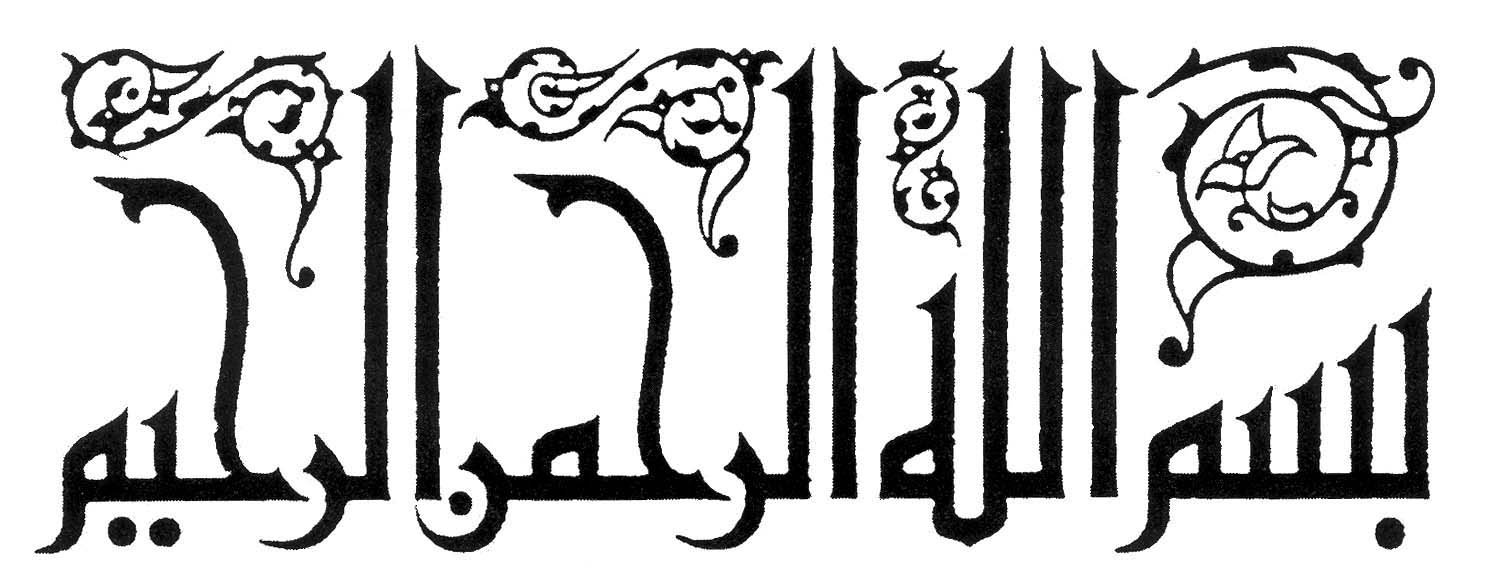
Initially, the cursive scripts were mostly used for secular or worldly functions because they fell short of style and discipline. With time, improvement has been made to ensure strict standardization and adherence to the rules. The dot and circle were adopted as units for determining line and letter proportions (Sakkal 9). The thuluth is mostly used for ornamental writing and came up in the 11th century.
The Naskh was developed in the 10th and has a rhythmic line. It is used for writing the Qur’an because of its simplicity in reading and writing and is deemed as the ultimate script.

Calligraphy is also written in form of pictures to convey different messages such as figure 3.
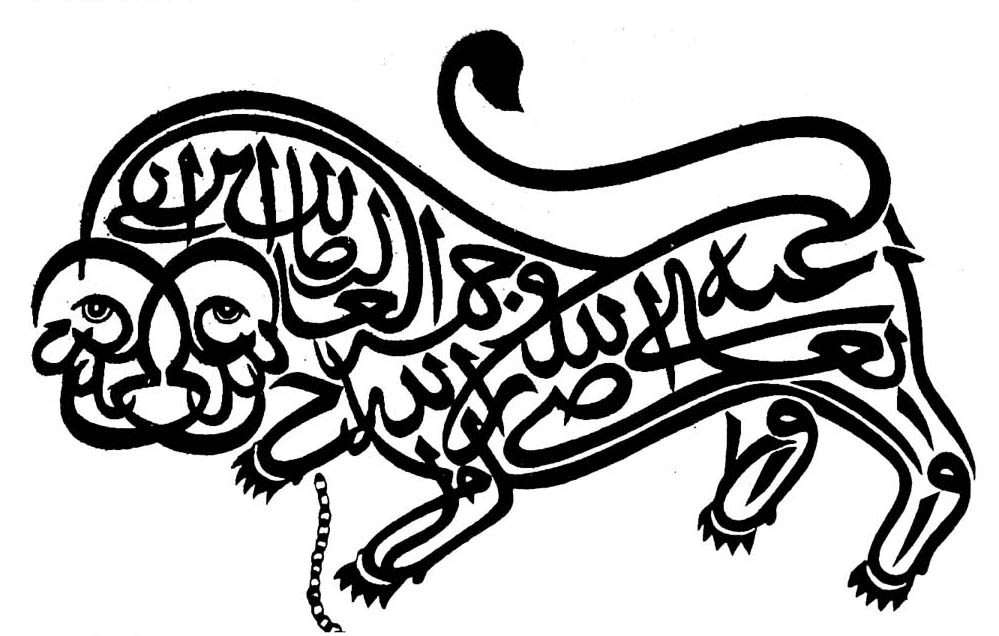
Calligraphers used reed and brush pens for doing their calligraphy. Other tools included knives, ink pots, scissors and sharpening tools. The alif is the unit of proportion in calligraphy.
Importance of calligraphy in Islamic art
The art of calligraphy has been embedded in the Islamic culture and is used in virtually every form of their activity. But why have Muslims embraced this form of art?
Calligraphy in Islamic art is a sign of the cultural values of the Muslims. It signifies their identity. It is used as a form of worship and in spiritual activity in glorifying and beatifying Allah’s words (Mossalli 1). Its inscriptions are used to identify places such as mosques, madrassas and mausoleums. In addition, it shows various types of historical information such as dates and artists and used as a form of decoration.
Calligraphy in the Quran
The Qur’an is the vital instrument for the Muslims just like the Holy Bible is for Christians. It is the Holy Bible for the Muslims. It is God’s word that was delivered through Archangel Gabrielle to Prophet Muhammad during the 23years he was a prophet (“What is Islam?” 5). It consists of 114 surahs and divided into three periods:
- The early surah written prior to Muhammad’s departure to Medina before Hejira in the years 610-622 AD.
- The median surah written during his time at Medina between 622-630AD. During this time, the Jihad doctrine was formulated.
- The late surah written before his death between 630-632AD.
According to Welch, calligraphy writing was introduced in Islam as a result of a revelation in the Qur’an. It was revealed that calligraphy is a beautiful script written using a pen and Allah preserves it. This led to its use in all the Islamic activity, buildings and books. He quotes:
Thy Lord is the Most Bounteous,
Who teacheth by the pen,
Teacheth man that which he knew not.
— (Surah al-Alaq, 96:3-5). (qtd. in Mubireek 5)
The writing in the Qur’an was originally done using calligraphy in the Kufic style. However, styles of writing such as Naskh have also been used to write the Qur’an.
Examples of calligraphy in the Quran are shown in figure 4 and figure 5.
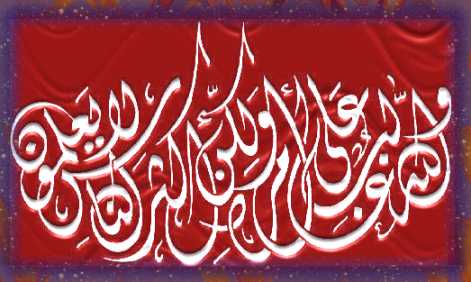

Calligraphy inscription in Timurid buildings
Under Timur’s rule, different architectural designs were introduced in Timurid in 1390. Many buildings were put up in Herat and Samarkand (Dickens 15). Numerous artists were brought and encouraged to articulate their ideas and this led to a variety of designs. The calligrapher at Timurid, Omar, was able to translate the Qur’an into small and large volumes. The successor of Timur also introduced his own unique designs of the mosques, madrasas, and etcetera. Despite these, most of its architecture was borrowed from the Persian architecture which introduced mausoleums as funerary places and khans (caravanserai). The Timurid architecture also borrowed the exterior tile decoration from the Persian architecture. Muqarnas were used but over time, they were replaced with intersecting arches which could be changed to different forms. Moreover, more colour and tiles were used during this period. The tiles had stucco or terra-cotta decorations.
After the adoption of calligraphy in the writing of Qur’an, it was passed onto building inscriptions.
Different calligraphy and architecture are applied and used in decorating the interior and exterior of buildings. Basing on the region where the building has been set up, the architecture can be Timurid, Persian, Ottoman, Azbeijan and Indo-Islamic. The wall and window inscriptions are copied from the Quran and Hadith. The function of the building is defined by the inscriptions and calligraphy i.e. mosques have different inscriptions from the madrasas or mausoleum.
In the early Timurid architecture, structures had axial symmetry and double domes. In addition, bright colours were utilized for decorative purpose. Depending on the type of building, some features like the minarets, mihrabs, iwans and muqarnas were either included or left out. For example, a palace, such as the AqSaray, was not domed.
Identities for the Islamic architecture
Islamic architecture in buildings is easily identified by the following features:
- Domes
- Towers or minarets which were used as watchtowers.
- A four iwan plan with halls facing Mecca.
- Mihrab (niche in the wall) pointing to the direction of Mecca.
- Iwans leading to the main hall and used for prayers, teachings and book keeping.
- Geometric patterns
- Islamic calligraphy with no pictures.
- Mocarabe and muqarnas – muqarnas are decorative elements and are mainly in 3D.
- Central fountains
Mosques
Calligraphy is widely used in the inscription of internal and external walls of the mosques. Mosques are buildings for worship in the Islamic culture and a lot of attention is paid when doing its inscriptions. The building’s architecture consists of minarets, iwans, mihrab, calligraphy, central fountains and domes. Quran messages written on the windows, walls and the minarets are about Allah, Prophet Muhammad and his sayings and teachings.
Various forms of roofing for mosques are used including the dome, the T type and Abbasid. The dome is the most common form of roofing and was launched in the 15th century. The dome normally covers the prayer hall.
The Mir Chaqmaq mosque in Yazd, Iran was built using the Timurid architecture in 1437. Bricks were used for construction. No minarets were put and a four-iwan structure was done. Mosaic tiles were used for decoration as shown in figure 6. Other mosques built using Timurid architecture include Bibi-Khanum mosque. This mosque was built by Timur and was used to show his immense concern for art.

Madrasas
The Madrasa is an example of a school where Islamic history, content and literature is taught plus the preservation of the Islamic tradition. The Imam Reza Complex was constructed in 1439 and consists of a double domed iwan plan with niches. The iwans are vaulted and the one at the southwest has a mihrab. Mosaic and haft-rangi tiles have been utilized as forms of decorative art.
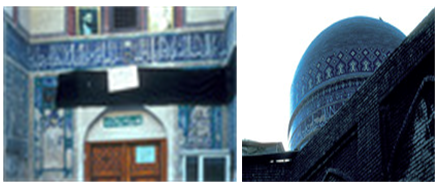
Palaces
Palaces are buildings where the rulers of the timurid resided. Most of the palaces were epitomes of beauty with excellent decor consisting of silk, gold and carpets (Dickens 16). The palace was used for carrying out public duties such as solving disputes, social arena and for holding meetings.
Between 1379 and 1396, Timur constructed the Aqsaray palace in Shakhrisabz, Uzbekistan. It was constructed using the timurid architecture with a niche on its west side. Most of the building’s decoration was done using glazed tiles and motifs and had no dome. The palace was almost totally damaged in the 16th century but the ruins are still standing up to date (Dickens 16).
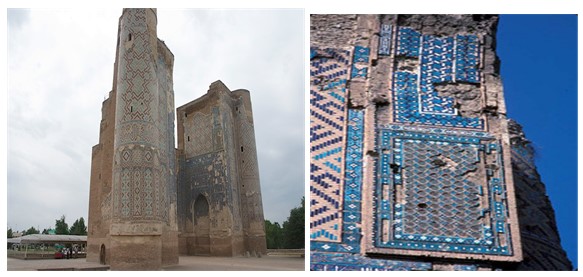
Mausoleums
The mausoleums had cylindrical, octagonal or square shapes with domes. The wall inscriptions and calligraphy bore messages of death, resurrection and paradise. The words are obtained from the Qur’an (Saoud 11). The mausoleums were built at the cemeteries or next to mosques or madrasas. The Qazizadeh Rumi mausoleum in Samarkand, Uzbekistan was built in 1420. It consisted of domed halls and interiorly decorated using muqarnas. Its exterior was coloured bright blue depicting one of the features of Islamic architecture.
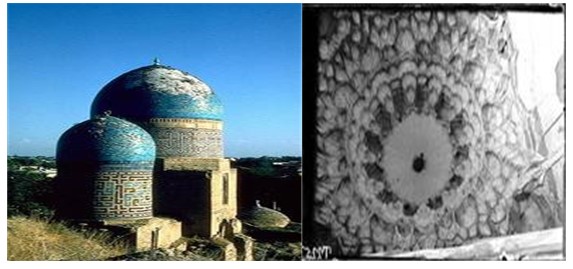
Khans or caravanserais
The Khans were built for use by travellers. They were positioned at intervals and were set up due to the Islamic emphasis on charity. The buildings consisted of courtyard and iwans. The rooms were organized according to the intended function. The khan’s structure was square in shape. Its walls were very strong and supported by semi circular towers. Most travellers who stopped at the Khans were provided with food, water and a place to sleep and keep their horses (Saoud 10).
Contemporary development of Islamic art and architecture
Various factors determine a building’s quality. These include, the type of material used, the structure employed, and its dimension. With the growth of modern and industrial developments in almost all aspects of life, the Islamic world has not been left out. This has caused an identity crisis since the western technology has started taking root and the traditional Islamic culture is slowly being edged out. For instance, computer technology has been on a steady increase in the recent past and this has resulted in no major advancement on the Islamic calligraphy and art other than the usage of digital media and computer technology to improve the already existing work. Similarly, the crisis has taken toll on the various architectural designs and construction of buildings and has necessitated the use of modern technology in all the processes such as planning and designing thus crafting an unfamiliar atmosphere in the Middle East.
Unity is a key factor in ensuring the Islamic communities preserve their culture. Architect Martin states that:
The concept of Unity in multiplicity is the determining factor in integrating Islamic societies. Historically the revelation of Islam as expressed by the prophet Mohammed and the Holy Koran brought together the most diverse cultures and peoples from Spain across to India and beyond. The architecture of the Islamic world throughout history adapted and responded to different cultures and existing traditions of buildings without weakening the spiritual essence which was its source of inspiration. Urban centers in Islamic cities evolved over long periods of time with generations of craftsmen whose sensitivity and experience added variety and a diversity of styles to the environment. The traditional Islamic city reflected a unity which related the architecture of the mosque, the madrassa , the souq, palace and the home as a sequence of spaces… The identity of the city lay in the relationship of its elements. These relationships were generated by the harmonizing of the community with the forces acting on it, which enabled the interaction of cultures, building methods and methods to evolve an Islamic identity in the same way a language maintains its own identity even when it absorbs outside words. (qtd. in “Islamic Architecture” 6)
To apply the modern technology and still retain the traditional culture, a compromise has to be reached. This is done by applying the technology offered to express the Islamic architecture. New materials, designs and construction methods are used for building erections while their Islamic art of calligraphy is used for decorative purposes. In other regions of the Middle East, the ancient technology has been left behind and modern technology has been adopted while in other regions, the opposite is done (modern technology has been disregarded and the community has opted to retain its traditional culture).
Architects such as Hassan Fat’hy, Rifat Chadirji and Basil Al-Bayyati have been looking for diverse ways of ensuring that contemporary architecture is still expressed in the tradition of the Islamic culture. As one puts it:
These and many more such as: Basil Al-Bayyati, and Abdel Wahed El Wakil are the gladiators in the arena of competing concepts of architecture in the Muslim world. They have contributed significantly to the evolving patterns of the built environment, to the intellectual debate prevailing in the Muslim world, and to the architectural profession’s image of its role as articulator and promulgator of societal values. (“Islamic Architecture” 9)
Conclusion
The Islamic art and architecture are some of the richest forms of art. Calligraphy is used as a decorative form of writing. Calligraphy originated from the Arabian script and was first used in the Quran. Calligraphy was visually used as a sign of worship to glorify Allah and His words, as a sign of identity, in providing historical information and as a form of decoration. Calligraphy is classified into the kufic and cursive scripts of writing. Islamic architecture is described in all their buildings including mosques, madrasas, palaces, shrines, mausoleums and tombs. Different features of the buildings’ architecture include, towers also known as minaret, domes, mihrabs, muqarnas and geometric patterns.
The Timurid architecture has been studied with reference to the various types of inscriptions in their buildings, how calligraphy was started in the Qur’an and the contemporary or modern development of the Islamic art. With the era of industrial development, most of the Arabic countries embracing Islam are shifting towards modernization and this is seen in the types of buildings being erected. Despite this, some countries are still clinging to their traditional culture while others are applying modernization and traditional aspects of their culture to ensure culture preservation.
Works Cited
Blair, Sheila S. and Jonathan Bloom. The Art and Architecture of Islam 1250-1800. Yale University Press, 1994. 37-54.
Dickens, Mark. Timurid Architecture in Samarkand. 1990. Web.
Golombek, Lisa and Donald Wilber. The Timurid Architecture of Iran and Turan. Vol 1and 2. Princeton: Princeton University Press, 1988.
“Islamic Architecture”. The Future of Islamic Architecture. 2004. Web.
Mossalli, Marriam. Amin Introduces a New Dimension to Calligraphy. Halal Journal, 2011.
Mubireek, Khalid. Arabic Calligraphy. 2000. Web.
Oweis Fayeq. The Art of Arabic Calligraphy. Web.
Paschuk, Melissa. Islamic Calligraphy.2005.
Sakkal, Mamoun. Art of Islam: History of Calligraphy. 1993. Web.
Saoud, Rabah. Muslim Architecture under Seljuk Patronage (1038-1327).
Thackston, Wheeler. A Century of Princes: Sources on Timurid History and Art. The Aga Khan Program for Islamic Architecture. 1989.
“What is Islam?” The Rise of Islam. Web.